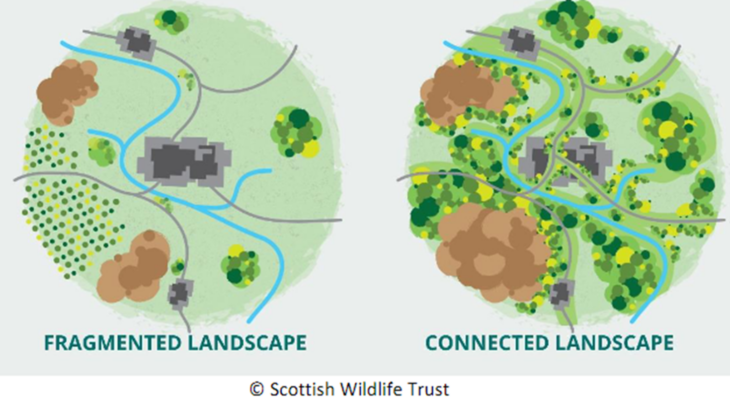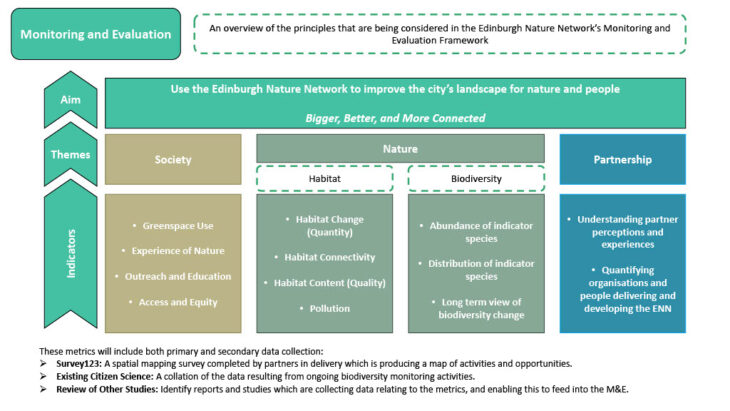Monitoring and Evaluating the Edinburgh Nature Network
,
Nature networks are growing in stature across Scotland within environmental planning. The Scottish Government’s Fourth National Planning Framework points to nature networks as a key tool to driving positive outcomes for biodiversity, and it outlines the requirement for all local authorities to facilitate the creation of nature networks as part of their environmental policy.
In creating a connected system of places which are deemed important for wild flora and fauna, we can enable biodiversity to move freely through the urban environment and adapt to changes, which will allow plants and animals to flourish with increased resilience.
Edinburgh’s Nature Network (ENN) was Scotland’s first and has led the way in showcasing opportunities for improved ecological connectivity, particularly in an urban context. The ENN was developed as a partnership between the City of Edinburgh Council and Scottish Wildlife Trust, with initial mapping from the University of Edinburgh, as part of the Thriving Green Spaces project.

How do we assess impact?
To track the progress of the Edinburgh Nature Network, and the potential impact that the ENN is having on people and nature in the city, the Scottish Wildlife Trust developed a Monitoring and Evaluation Framework throughout 2023 and 2024. This framework outlines the core aims of the ENN, the indicators which are determining success, and the means and methods for data collection which will serve as an evidence base.
A series of workshops with a variety of representatives from 18 interested parties were undertaken throughout 2023. Led by the Scottish Wildlife Trust, these workshops sought to include the thoughts and values of the ENN’s delivery partners in formulating the Monitoring and Evaluation Framework. As partnership working is a key theme of the ENN, ensuring that a wide variety of values were considered was vital.
The Framework
An overview of the Monitoring and Evaluation Framework can be seen below:

Primary and Secondary data collection methods will feed into this and will act as the evidence base for all observed trends:
The Scottish Wildlife Trust has created a spatial mapping survey which is tracking the delivery of ENN actions and has produced a map showing this. Entries to the survey are being submitted by the ENN’s delivery partners, and these enable us to see how many of the ENN’s actions have been, or are being, delivered. If you belong to an organisation which is delivering actions for nature in Edinburgh, please contribute to the Edinburgh Nature Network by filling in the survey! For more information, including a full outline of all Edinburgh Nature Network actions, please visit the dedicated ENN mapping page.
Alongside this, relevant data from existing publications relating to the ENN’s metrics will be collated. This includes species monitoring from existing citizen science surveys, e.g. bird surveys or pollinator transects, and other habitat-related data, which will enable landscape scale trends on biodiversity, habitat and society to be established. Additional information can be found on our Story Map.
The ENN as Urban Conservation
Although all local authorities in Scotland are considering their nature networks, the intense focus on ecological connectivity and nature corridors within a predominantly urban setting is significant. Through the Edinburgh Living Landscape partnership, a group of organisations have committed to cohesive working to ensure that nature is at the heart of the city, and are aiming to make Edinburgh one of the most sustainable cities in Europe by 2050. The Edinburgh Nature Network is one way of further streamlining conservation activities in Scotland’s capital, and can represent the efforts of many in making Edinburgh a more ecologically-connected, nature-rich city.
Please visit the dedicated Edinburgh Nature Network webpage on the ELL website for further information.
__________________________________________________
Leo Charlesworth, Edinburgh Nature Network Manager 2024
